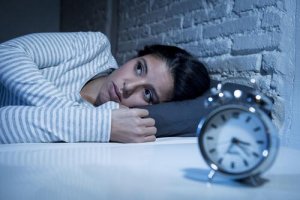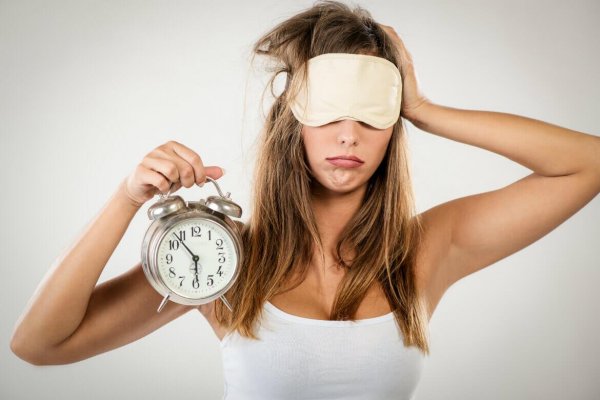Do You Have Any of These Circadian Rhythm Sleep Disorders?

Do you know what circadian rhythm sleep disorders are? Don’t worry, we will explain it here. Surely you have suffered from insomnia at least once. It’s something many people suffer from.
There are times when it’s hard for you to fall asleep. You go to bed, but you end up just tossing and turning and sleep just won’t come. Other times, you wake up before you wanted to, and you can’t go back to sleep. These are examples of insomnia.
This can be due to various factors. Most of the time, it’s a product of bad sleep hygiene habits (watching TV right before bed, taking any kind of stimulant just before going to sleep…) Other times, it could be due to stress and excessive nervous system activation.
However, circadian rhythm sleep disorders are characterized simply due to interruptions of the circadian sleep rhythm. The circadian rhythm is the name given to the “biological clock” that regulates the (approximate) 24 hour cycle of animal and biological processes.
What are circadian rhythms?
Circadian rhythms are intrinsic biological rhythms that are periodic in nature. They happen in 24 hour intervals. These rhythms are based on the daily rotation of the Earth around the sun (the day-night cycle). The name comes from the Latin word “circa”, which means “approximately”, and “dian”, which means “day”. So circadian rhythm means “approximately a day”. For mammals, the most important circadian rhythm is the wake-sleep cycle.
Circadian rhythms are not only found in human beings. Almost all forms of life, including plants, flies, fish, bacteria, and so on, have circadian rhythms. Any process involved in natural sleep functions according to circadian rhythms. As human beings, we are designed to have a natural sleep cycle that is in harmony with our wake-sleep cycle. This is how we can sleep at night and be awake during the day.
Circadian rhythms are important not only for determining animals’ sleeping and eating patterns. They are also paramount for all hormonal activity, cellular regeneration, and brain activity, among others.

Our biological clock
Various researchers have reached the conclusion that there must be a structure in our body that is in charge of establishing our circadian rhythms.
In fact, that structure does exist, and it’s called the suprachiasmatic nucleus. We find the suprachiasmatic nucleus in the hypothalamus, in the brain. It is situated just behind our eyes. This region is in charge of making us sleep at night and stay awake during the day.
Circadian rhythm sleep disorders
If you sleep or wake up some hours later or earlier than you should, in general it doesn’t necessarily mean you have a problem. However, it can become a problem when you are incapable of waking up, or you cannot stay awake while you work.
If that’s the case, then your sleep schedule becomes the problem, and you could be diagnosed with a circadian rhythm sleep disorder.
Diagnostic criteria
Circadian rhythm sleep disorders show some of the following symptoms:
- A continuous or recurring interruption of sleep. A pattern due to a change in the circadian system or to a misalignment between the circadian rhythm and the endogenous circadian rhythm and necessary wake-sleep synchronization. This could be linked to a person’s physical environment or their social or professional schedules.
- This sleep interruption leads to excessive sleepiness or insomnia, or both.
- The alteration of sleep causes clinically significant problems or deterioration in social, work or other important areas in which a person has an active role.

What types of circadian rhythm sleep disorders exist?
There are several types of circadian rhythm disorders, according to the Diagnostic and Statistical Manual of Mental Disorders (DSM-5):
- Delayed sleep phases
- Advanced sleep phases
- Irregular wake-sleep cycles
- Non-24-hour wake-sleep cycles
- Associated with shift work
- Unspecified
Delayed sleep phases
This is a when sleeping time is delayed (generally more than two hours) compared to a desired schedule for sleeping and waking up. This causes insomnia and excessive sleepiness.
When they can establish their own sleep schedule, people with a delayed sleep phase can have normal sleep quality and duration for their age. However, they may have symptoms such as insomnia when laying down to sleep, difficulty in waking up in the morning and excessive sleepiness at the beginning of the day.
These symptoms tend to start in adolescence or in early adulthood. They can last for several months or years before being diagnosed. This can become less serious with age, and symptoms frequently reappear. A change in school or work schedules that requires waking up earlier than usual can make the situation worse.

Advanced sleep phases
This is when wake-sleep times are several hours earlier than desired or compared to conventional times. It is diagnosed when there is a history of sleeping on an advanced schedule (normally more than 2 hours) compared to the desired time for sleeping and waking up.
The symptoms can be waking up early and excessive sleepiness during the day. When a person with this disorder can create their own sleep schedule, their sleep quality and duration is normal for their age. Advanced sleep phases can be documented through family patterns. There tends to be a family history of advanced sleep phases for people with this kind of disorder.
It generally begins in late adulthood, and can be persistent, lasting for over 3 months.
Irregular wake-sleep cycles
A person with irregular wake-sleep cycles usually has a history of insomnia at night (during normal sleeping times) and excessive sleepiness (napping) during the day. It’s characterized by an absence of a recognizable circadian wake-sleep rhythms. There is no main sleeping time, and sleep is fragmented into at least three periods throughout the 24 hours of the day.
Non-24-hour wake-sleep cycles
Diagnosing this type of disorder is based mainly on a history of symptoms of insomnia or excessive sleepiness due to abnormal synchronicity between the 24 hour dark-light cycle and the circadian rhythm. People with this disorder have periods of insomnia, excessive sleepiness, or both. They alternate between periods with and without symptoms.
This is more common for people who are blind or have impaired vision because they have less light perception. People with this disorder who have their sight intact may also sleep for longer periods of time.

Associated with shift work
People with this disorder have a regular work schedule outside the normal “nine to five” schedule (especially night shifts).
The clearest symptoms are excessive sleepiness at work and sleep problems at home. These symptoms disappear when the person returns to a regular work routine. On the other hand, people who travel to different time zones can often have similar symptoms.
If you have any of these circadian rhythm sleep disorders, we recommend that you re-establish “normal” sleep habits as soon as possible. Maybe this is difficult for you or you can’t do it yourself, in which case, we recommend that you see a psychologist to treat the problem.
Bibliographic references:
American Psychiatry Association (2014). Diagnostic and Statistical Manual of Mental Disorders (DSM-5), 5th Edition. Madrid: Editorial Médica Panamericana.
All cited sources were thoroughly reviewed by our team to ensure their quality, reliability, currency, and validity. The bibliography of this article was considered reliable and of academic or scientific accuracy.
Bibliografiske referanser:
American Psychiatry Association (2014). Diagnostisk og statistisk håndbok for psykiske lidelser (DSM-5), 5. utgave. Madrid: Editorial Médica Panamericana.
This text is provided for informational purposes only and does not replace consultation with a professional. If in doubt, consult your specialist.








